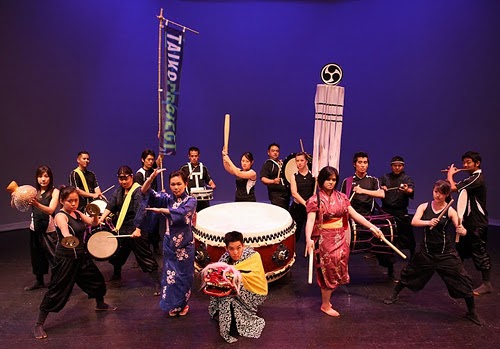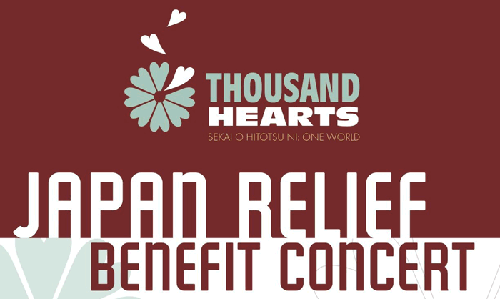July 4, 2011
World Compass: “Interview Boxed” show discussing March Japan disasters
This was taped several months ago but it took a while for the folks at World Compass to post it online. The host,...

This was taped several months ago but it took a while for the folks at World Compass to post it online. The host,...
 Another reason I wish we lived in LA: TaikoProject, the acclaimed genre-expanding taiko group based in LA, brings its talents home to perform its "Rhythmic Relations 2011" show this weekend outdoors at Noguchi Plaza in front of the Japanese American Cultural & Community Center in Little Tokyo, 244 S. San Pedro St., Los Angeles.
There will be two performances, at 2 and 7:30 pm; tickets are $30 - $35 + service charges. Tickets are available online at www.jaccc.org or by phone (213) 680-3700. The group will be joined by Bombu Taiko, Kitsune Taiko and Loma Pacific Taiko, and the show will feature special guest Ryutaro Kaneko (former Artistic Director for the superstar Japanese taiko group Kodo).
You may have caught TaikoProject this week on "The Voice," the terrific NBC singing competition show (we're cheering for Dia Frampton, and not just because she's Asian American -- hapa Korean). You may have also seen TaikoProject way back in 2006, playing on a Mistubishi car commercial (I remember at the time, thought it was totally cool to see a taiko group on a commercial).
Here's how TaikoProject describes itself:
Another reason I wish we lived in LA: TaikoProject, the acclaimed genre-expanding taiko group based in LA, brings its talents home to perform its "Rhythmic Relations 2011" show this weekend outdoors at Noguchi Plaza in front of the Japanese American Cultural & Community Center in Little Tokyo, 244 S. San Pedro St., Los Angeles.
There will be two performances, at 2 and 7:30 pm; tickets are $30 - $35 + service charges. Tickets are available online at www.jaccc.org or by phone (213) 680-3700. The group will be joined by Bombu Taiko, Kitsune Taiko and Loma Pacific Taiko, and the show will feature special guest Ryutaro Kaneko (former Artistic Director for the superstar Japanese taiko group Kodo).
You may have caught TaikoProject this week on "The Voice," the terrific NBC singing competition show (we're cheering for Dia Frampton, and not just because she's Asian American -- hapa Korean). You may have also seen TaikoProject way back in 2006, playing on a Mistubishi car commercial (I remember at the time, thought it was totally cool to see a taiko group on a commercial).
Here's how TaikoProject describes itself:
 We're thrilled to announce that we're celebrating the second anniversary of visualizAsian.com with TWO shows during Asian American Pacific Islander Heritage Month! We launbched visualizAsian in May of 2009 with a conversation with former Transportation Secretary Norm Mineta, and we've had almost two dozen calls since then.
This month we have a show with Albert Kim, one of the writers and producers of the hit action series "Nikita" on Tuesday May 10, and we're closing out the month with a conversation with journalist and author Cheryl Tan on Tuesday, May 24! Click here to register for the call and you'll receive the dial-in and webcast information.
Cheryl Tan has written for bigtime publications including the New York Times and Wall Street Journal, and earlier this year published "A Tiger in the Kitchen" (not to be confused with that other "Tiger" book...). Here's her biography from her website:
We're thrilled to announce that we're celebrating the second anniversary of visualizAsian.com with TWO shows during Asian American Pacific Islander Heritage Month! We launbched visualizAsian in May of 2009 with a conversation with former Transportation Secretary Norm Mineta, and we've had almost two dozen calls since then.
This month we have a show with Albert Kim, one of the writers and producers of the hit action series "Nikita" on Tuesday May 10, and we're closing out the month with a conversation with journalist and author Cheryl Tan on Tuesday, May 24! Click here to register for the call and you'll receive the dial-in and webcast information.
Cheryl Tan has written for bigtime publications including the New York Times and Wall Street Journal, and earlier this year published "A Tiger in the Kitchen" (not to be confused with that other "Tiger" book...). Here's her biography from her website:
It's great that so many local benefits in the Denver area are being held event for Japan disaster relief, but I wish some weren't so ad-hoc and we had more time to promote them. Here's one you have a week to plan for, "Unite for Japan" next Friday, April 29 at the Aztlan Theater, 974 Santa Fe Dr. (doors open...
 Japan relief efforts in Los Angeles should get a big boost next weekend from the all-star concert being organized by Asian American organizations including the Asian Bar Association and the Asian American Journalists Association. "A Thousand Hearts" promises to be a great show as well as hopefully, a great fundraiser.
As always, wish I lived in Cali, but if any of you readers are in the area, don't miss it.
Here are the details via press release:
Japan relief efforts in Los Angeles should get a big boost next weekend from the all-star concert being organized by Asian American organizations including the Asian Bar Association and the Asian American Journalists Association. "A Thousand Hearts" promises to be a great show as well as hopefully, a great fundraiser.
As always, wish I lived in Cali, but if any of you readers are in the area, don't miss it.
Here are the details via press release:
This website uses cookies to improve your experience. We'll assume you're ok with this, but you can opt-out if you wish. Read More


